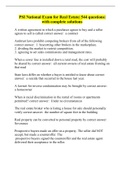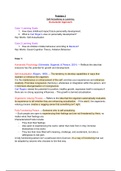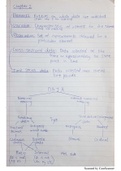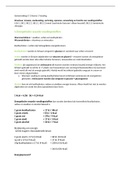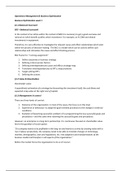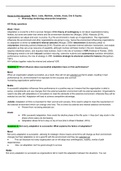Onderzoekspracticum 3: Experiment
Webcollege over de 4 elementen van een zuiver experiment.
The Milgram Experiment
• Example: obedience to authority
• World famous study by Stanley Milgram.
• How far would people go in obeying an instruction if it involved harming another person?
• 65% continued to highest level
Elements of experimental designs
Element 1: Manipulation
• The researcher manipulates one variable by changing its value to create a set of two or more treatment
conditions.
• The independent variable
• A researcher wants to research different levels of an independent variable and therefore creates different
manipulations that leads to different conditions, treatments or levels
• Example: Disclosing Influencer Marketing
Element 2: Measurement
• A second variable is measured for a group of participants to obtain a set of scores in each treatment condition.
• The dependent variable
• Example: Disclosing Influencer Marketing
o Measurement of Ad Recognition in both conditions
Element 3: Comparison
• The scores in one treatment condition are compared with the scores in another treatment condition.
• Consistent differences between treatments are evidence that the manipulation has caused changes in the scores.
• To compare something you need to have a manipulation and you need to measure something.
• Example: Disclosing Influencer Marketing
o Comparison on Ad Recognition between condition 1 (no disclosure) and condition 2 (disclosure)
,Element 4: Control
• All other variables are controlled to be sure that they do not influence the two variables being examined
• Example: Disclosing Influencer Marketing
o Control every other variable (besides from IV and DV) to make sure there is no influence on DV.
o Control variables:
▪ Familiarity with YouTuber, Brand familiarity, gender, age, grade
o Other controlled factors:
▪ Children were randomly assigned to conditions
▪ Procedure was exactly the same for both conditions
Experiment?
World famous ‘Milgram Experiment’ But! Is this a true experiment?
X manipulation?
V measurement?
X comparison?
V control?
Milgram = No true experiment
Webcollege over het verschil tussen correlatie en causaliteit.
So what do you need to do to provide evidence for a causal relation?
• Use an experimental research strategy!
• The goal of the experimental research strategy is to establish the existence of a cause-and-effect relationship
between two variables.
• Cause -> Effect
The Experimental Research Strategy
, The Experimental Research Strategy
• By manipulating the independent variable we create different groups, and the
groups receive different treatments.
• The different scores of the dependent variable are caused by the treatment (IV),
unless…
• Independent variable -> Dependent variable
Extraneous variables
• ... Unless extraneous variables are involved
• Extraneous variables= All variables beyond the independent and dependent
variables.
• Every experiment is filled with them!
• The goal of a proper experimental design is to control these extraneous variables and prevent them from
becoming confounding variables
Confounding variables
Extraneous variables are problematic when they become confounding variables:
• …if it influences the dependent variable. Something totally unrelated to the dependent variable is not a threat
• …if it varies systematically with the independent variable. A variable that changes randomly, with no relation to
the independent variable, is not a threat.
Potential confounding variables in the Influencer Marketing study?
• Familiarity with YouTuber, Brand familiarity, gender, age, grade
• Others?
• Time of day, Hunger
Controlling extraneous variables
• Once a limited set of specific variables with real potential as confounding variables is identified, it is possible to
control them.
• 3 methods to control extraneous variables:
o 1. Randomization
o 2. Holding a variable constant
o 3. Matching
Control by randomization
50% chance for someone to end up in each group. Within group differences, but between group there needs to be as
small as possible differences.
Control by holding a variable constant
Webcollege over de 4 elementen van een zuiver experiment.
The Milgram Experiment
• Example: obedience to authority
• World famous study by Stanley Milgram.
• How far would people go in obeying an instruction if it involved harming another person?
• 65% continued to highest level
Elements of experimental designs
Element 1: Manipulation
• The researcher manipulates one variable by changing its value to create a set of two or more treatment
conditions.
• The independent variable
• A researcher wants to research different levels of an independent variable and therefore creates different
manipulations that leads to different conditions, treatments or levels
• Example: Disclosing Influencer Marketing
Element 2: Measurement
• A second variable is measured for a group of participants to obtain a set of scores in each treatment condition.
• The dependent variable
• Example: Disclosing Influencer Marketing
o Measurement of Ad Recognition in both conditions
Element 3: Comparison
• The scores in one treatment condition are compared with the scores in another treatment condition.
• Consistent differences between treatments are evidence that the manipulation has caused changes in the scores.
• To compare something you need to have a manipulation and you need to measure something.
• Example: Disclosing Influencer Marketing
o Comparison on Ad Recognition between condition 1 (no disclosure) and condition 2 (disclosure)
,Element 4: Control
• All other variables are controlled to be sure that they do not influence the two variables being examined
• Example: Disclosing Influencer Marketing
o Control every other variable (besides from IV and DV) to make sure there is no influence on DV.
o Control variables:
▪ Familiarity with YouTuber, Brand familiarity, gender, age, grade
o Other controlled factors:
▪ Children were randomly assigned to conditions
▪ Procedure was exactly the same for both conditions
Experiment?
World famous ‘Milgram Experiment’ But! Is this a true experiment?
X manipulation?
V measurement?
X comparison?
V control?
Milgram = No true experiment
Webcollege over het verschil tussen correlatie en causaliteit.
So what do you need to do to provide evidence for a causal relation?
• Use an experimental research strategy!
• The goal of the experimental research strategy is to establish the existence of a cause-and-effect relationship
between two variables.
• Cause -> Effect
The Experimental Research Strategy
, The Experimental Research Strategy
• By manipulating the independent variable we create different groups, and the
groups receive different treatments.
• The different scores of the dependent variable are caused by the treatment (IV),
unless…
• Independent variable -> Dependent variable
Extraneous variables
• ... Unless extraneous variables are involved
• Extraneous variables= All variables beyond the independent and dependent
variables.
• Every experiment is filled with them!
• The goal of a proper experimental design is to control these extraneous variables and prevent them from
becoming confounding variables
Confounding variables
Extraneous variables are problematic when they become confounding variables:
• …if it influences the dependent variable. Something totally unrelated to the dependent variable is not a threat
• …if it varies systematically with the independent variable. A variable that changes randomly, with no relation to
the independent variable, is not a threat.
Potential confounding variables in the Influencer Marketing study?
• Familiarity with YouTuber, Brand familiarity, gender, age, grade
• Others?
• Time of day, Hunger
Controlling extraneous variables
• Once a limited set of specific variables with real potential as confounding variables is identified, it is possible to
control them.
• 3 methods to control extraneous variables:
o 1. Randomization
o 2. Holding a variable constant
o 3. Matching
Control by randomization
50% chance for someone to end up in each group. Within group differences, but between group there needs to be as
small as possible differences.
Control by holding a variable constant

